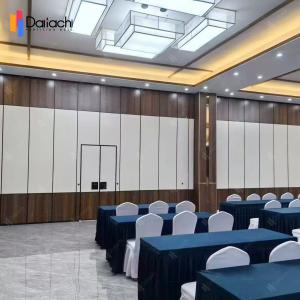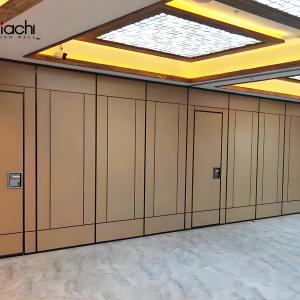In modern corporate and community buildings, movable walls are an increasingly popular solution for enhancing space flexibility and utilization. These operable acoustic walls allow spaces to be quickly re-divided or reconfigured, offering a range of benefits in dynamic environments. Movable Partition Walls are typically categorized into three types based on their mode of operation: manual, semi-automatic, and fully automatic. This guide explores the key differences between these partition wall systems, helping you choose the right option for your needs.
A movable wall, also known as a removable wall or partition, is a versatile wall system designed to be repositioned, reinstalled, or removed. Its primary function is to create flexible layouts by dividing large spaces into smaller, more functional areas. Movable sliding folding partition walls are commonly used in offices, meeting rooms, exhibition centers, clubs, art centers, stadium, sports centers, residential spaces, and other multi-purpose environments.
Acoustic Folding Walls come in two main forms: modular and unitized. Modular walls consist of individual panels that are assembled on-site, offering flexibility in design and installation. Unitized walls, on the other hand, are pre-assembled as a single unit, making them quicker and easier to install.
The popularity of temporary sliding partition wall is driven by the increasing demand for efficient space usage. They provide a way to quickly alter a room's layout, whether for office meetings, private workspaces, or even changing the function of rooms in a residential setting.
Why Choose Movable Walls?
Movable walls offer several compelling benefits:
- Space Efficiency:
They allow for quick adjustments to a room's layout, making the best use of available space.
- Design Flexibility:
Movable walls help maintain a stylish and modern aesthetic while offering the flexibility to adapt the space according to changing needs.
- Improved Functionality:
Whether dividing a conference room into smaller meeting areas or separating living and sleeping areas in a home, movable walls enhance the functionality of any space.
Types of Movable Walls
1. Manual Movable Walls
Description: The Manual Movable Wall is the simplest and most cost-effective system. This operable wall type is manually operated, with users physically moving the panels into place. Once positioned, the partition panel is locked into place using a handle or lever mechanism. The locking system secures the top and bottom sealing parts of the wall to ensure stability.
Advantages:
- Cost-effective:
The manual foldable partition system is the least expensive, both in terms of installation and maintenance.
- Simplicity:
Operation is straightforward and intuitive.
- Low maintenance:
Few moving parts result in reduced maintenance needs.
Disadvantages:
- Labor-Intensive:
Requires manual effort to move the wall, which can be cumbersome in larger spaces.
- Limited Efficiency:
Not ideal for spaces that require frequent layout changes, as it can be time-consuming to adjust.
Best for: Small spaces where the layout does not need to change often, or for applications where a low-cost solution is preferred.
2. Semi-automatic Movable Walls
Description: Semi-automatic Movable Walls offer a combination of manual and automated features. These systems are equipped with an electronic locking system that automatically secures the partition panels after they are manually positioned. The user simply needs to move the partition wall to the desired location and activate the system to engage the locking mechanisms at the top and bottom of the wall.
Advantages:
- Faster Operation:
The automatic locking system reduces the time and effort required to secure the wall.
- Improved Stability:
Provides a more secure fit and enhanced sound insulation due to the automatic sealing of the wall panels.
- Battery Backup:
Many semi-automatic operable wall systems feature a battery backup to maintain operation during power outages.
Disadvantages:
- Higher Cost:
More expensive than manual systems due to the added electronic components.
- Limited Automation:
Still requires manual movement of the partition wall panels.
Best for: Medium-sized spaces where layouts need to be adjusted regularly but where full automation is not necessary. Ideal for offices or conference rooms that need periodic reconfiguration.
3. Fully Automatic Movable Walls
Description: Fully Automatic Movable Walls represent the most advanced and convenient system. These fully automatic movable sliding partition wall are driven by an electric motor, allowing them to move automatically to the designated position. Once in place, the wall partition system automatically locks the panels into position, sealing both the top and bottom. Many soundproof folding wall systems allow for turn-key or digital keypad operation, and the fully electric movable walls can be customized for speed, locking configurations, and other settings.
Advantages:
- Highly Efficient:
Fully automated operation significantly reduces manual labor and time spent adjusting the layout.
- Precision and Convenience:
The auto electric folding partition wall system is highly accurate, offering smooth and precise movement of the wall panels. Customizable settings make it adaptable to various needs.
- Remote Control Options:
The Electric Folding Wall can be controlled via turn-key switches or a digital keypad, offering flexibility in operation. Some systems even support wireless control for added convenience.
- Backup Power:
Battery backup ensures continuous operation even during power failures.
Disadvantages:
- High Cost:
The fully automatic room partition system is the most expensive option, both for initial installation and maintenance.
- Complexity:
The divider partition system's high-tech features may require more specialized maintenance and support.
Best for: Large spaces such as corporate offices, multi-functional halls, and conference centers where frequent or rapid layout changes are required. It is also ideal for environments seeking to minimize manual intervention and maximize space efficiency.
Summary: Choosing the Right Movable Wall
Each type of soundproof movable wall offers unique advantages and is best suited for specific needs:
Manual Movable Walls:
Ideal for small environments where space layout changes infrequently. They are cost-effective and simple to operate but require manual effort for movement.
Semi-automatic Movable Walls:
Suitable for medium-sized spaces that require moderate automation. They offer enhanced speed and sealing efficiency while still involving some manual movement.
Fully Automatic Movable Walls:
Best for large spaces and high-frequency layout changes. These systems provide maximum convenience, speed, and precision, with remote operation and minimal manual intervention.
Selecting the right moving partition wall depends on factors such as the frequency of layout changes, available budget, and the desired level of automation. By understanding the differences between manual, semi-automatic, and fully automatic systems, you can make an informed decision that optimizes both space utilization and operational efficiency.





